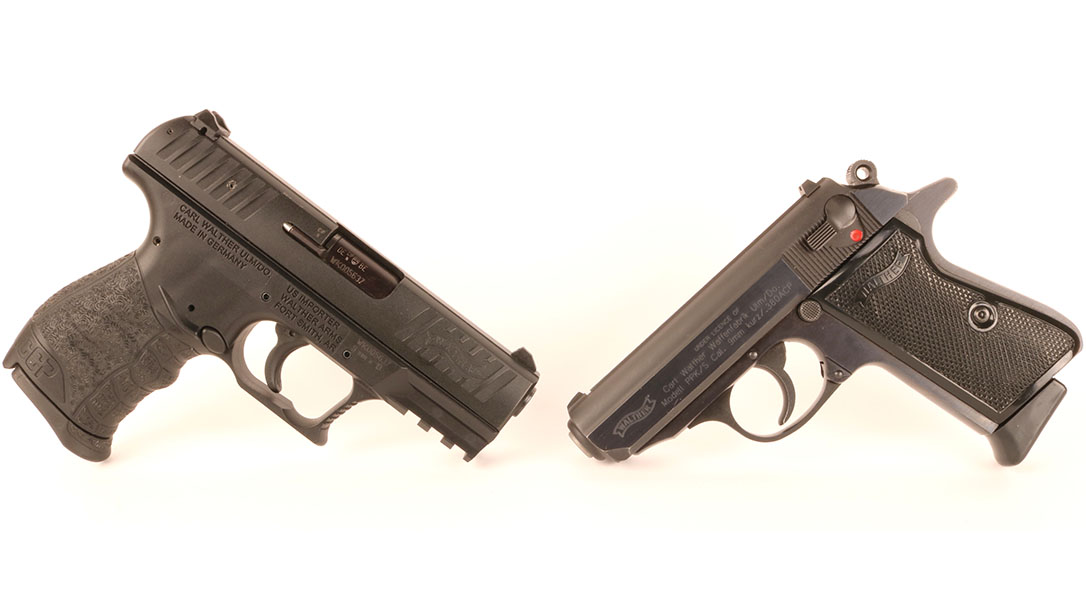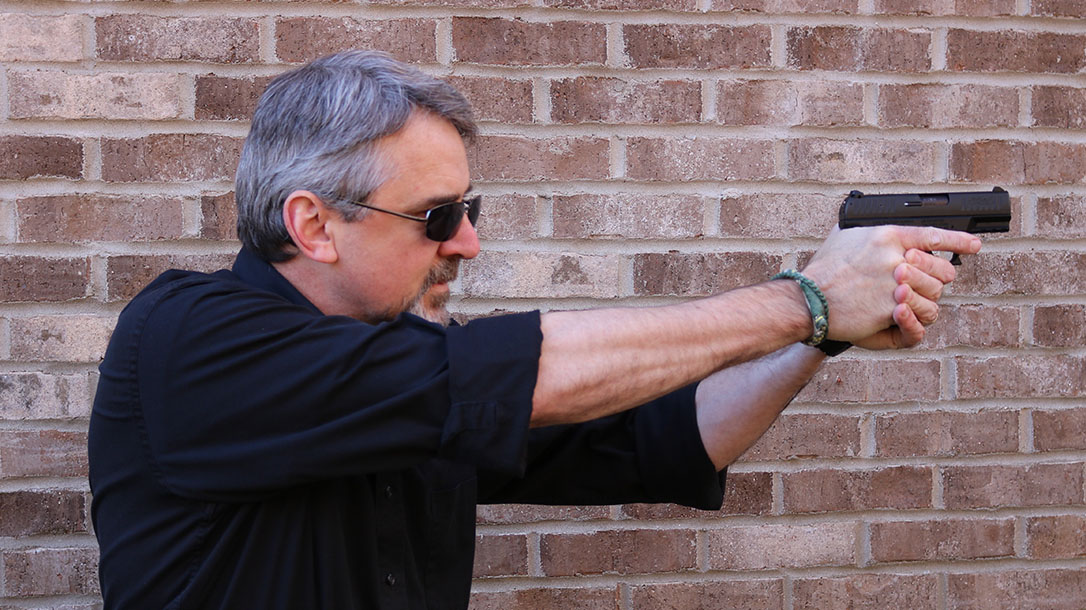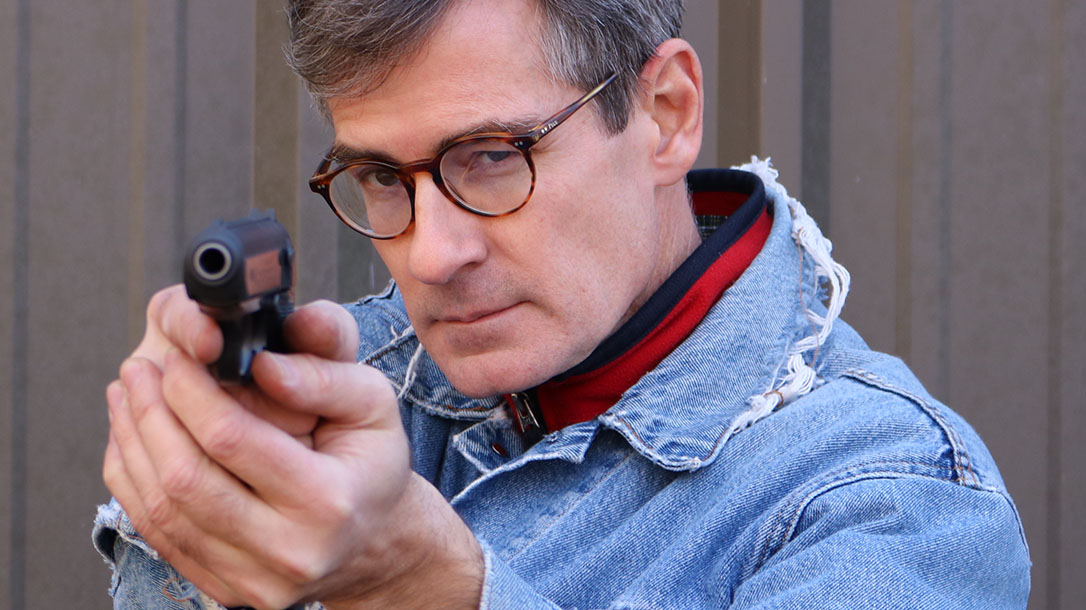In 1929, Carl Walther Waffenfabrik introduced a revolutionary new pistol that changed literally everything about combat handguns. The Polizeipistole (PP) was designed for law enforcement use and combined the revolver’s double-action/single-action (DA/SA) trigger with a compact semi-automatic handgun design. The gun world would never be the same.
The Walther PP utilized a fairly uncomplicated blowback mechanism and was offered in .22 LR, .25 ACP, .32 ACP and .380 ACP. And, thanks to its ingenious design, the gun could be safely carried with a round in the chamber ready to fire via a long DA trigger pull. Subsequent trigger pulls in SA mode were lighter and shorter. The PP incorporated a reliable internal safety mechanism, a handy magazine release and a last-round-hold-open feature, all in a remarkably svelte, compact and stylish chassis.
Advertisement — Continue Reading Below
The smaller PPK (Polizeipistole Kriminalmodell, or Police Pistol Detective Model) went on to become the definitive variant, and it is one of the world’s most iconic close-quarters defensive handguns. The Walther P38 used essentially the same trigger in an attempt to replace Georg Luger’s P08 during World War II. The PP and PPK armed a rogues’ gallery of Nazis throughout that planetary conflict.
The overwhelming majority of PPK pistols issued throughout WWII were chambered in .32 ACP. While this indeed made for a compact and sweet-shooting handgun, the downrange performance of this anemic cartridge was fairly underwhelming, particularly when launching FMJ bullets. Where the American M1911A1 in .45 ACP was a brawny handgun designed for serious close combat, the PPK was actually better suited as an executioner’s tool.
War Stories
Elvis Presley was fond of an engraved PPK sporting his characteristic “TCB” (“Taking Care of Business”) motto. Legend has it that the King gave his personal PPK to Hawaii Five-O actor Jack Lord as a gift in 1973.
Advertisement — Continue Reading Below
The most famous user of the iconic Walther PPK, however, is not even a real guy. Ian Fleming’s fictional MI6 agent James Bond carried a .25 ACP Beretta 418 in his earliest adventures. A firearms expert named Geoffrey Boothroyd eventually convinced Fleming to swap Bond’s standard handgun out for a PPK just in time for his run-in with Dr. No in 1958.
The United States was always the largest postwar market for PPK handguns, and the design was amended slightly to accommodate the 1968 Gun Control Act, which established morphological criteria that had to be met for small handguns to be importable into the U.S. The subsequent PPK/S sported a slightly longer frame that held an extra round in the magazine. While Walther still offered the smaller calibers, most post-war PPK pistols fed .380 ACP ammunition. Walther now produces the PPK and PPK/S in Arkansas.
Design Influence
While the internal safety features and loaded-chamber indicator of the PPK have become de rigueur on many modern combat handguns, it was the DA/SA trigger that really made a splash. The same basic mechanism drove most handguns until the 1990s. Familiar weapons like the Beretta M9, the Sig P226, the CZ 75 and various Smith & Wesson semi-autos of the day all used some variation of this trigger system. This design reigned supreme until Gaston Glock debuted the striker-fired Safe Action trigger system that has since transformed modern combat handguns.
Advertisement — Continue Reading Below
While most law enforcement pistols employ striker-fired triggers these days, the DA/SA mechanism remains a brisk seller. Many serious gunmen, myself included, enjoy the added safety of a long trigger pull for the first round out of the holster. Despite a literal lifetime of trying, I can never seem to shoot to precisely the same point of aim in both modes. However, I am personally acquainted with three accidental discharges that spawned from striker-fired handguns, two of which inflicted severe officer injuries. The DA/SA trigger still has a place among modern handguns even today.
Walther PPK/S
But let’s take a closer look at the PPK/S. This is a steel-framed, blowback-operated pistol with a rotating hammer-drop safety mounted on the left side of the slide. The thumb easily accesses this device when the gun is fired right-handed. The magazine release is thumb-activated like that of the revered 1911. The sights are fixed and fairly small, though the top of the slide sports wavy serrations to minimize glare.
The slide on the PPK/S locks to the rear automatically after the last round in the magazine is fired. Swap magazines and snatch the slide back slightly to release it over a fresh magazine. The recoil is snappy for a .380 ACP handgun given its unlocked blowback action. However, the gun remains both fun to shoot and a personal favorite.
Advertisement — Continue Reading Below
Next-Gen Treatment
That Walther is an established innovator in the field of combat handguns is indisputable. One of its most modern designs, however, remains absolutely unique among dozens of competitors. The Walther CCP uses a gas-delayed blowback operating system to put 9mm power into a .380-sized chassis. Walther calls this the Softcoil system.
Most modern combat rifles are gas-operated. There are a few exceptions to this rule, but not many. The details vary, and these individual details sell a lot of guns. However, most modern combat rifles tap a bit of gas off near the muzzle and use this energy to cycle the action and fire another round. Such contrivances allow a weapon to be much smaller and lighter than might be the case were the gun driven by pure unvarnished blowback. In the case of the CCP, Walther engineers took a basic gas piston design and turned it around backwards. In so doing, they slowed the action down rather than sped it up. The result is absolutely inspired.
CCP
The polymer-framed Walther CCP is subsequently thin, lightweight and portable. The CCP was designed from the outset for concealed-carry applications, and everything about the gun is optimized for this role. There are no sharp angles to snag, and thanks to the gas-retarded operating system, the slide is remarkably easy to rack.
Advertisement — Continue Reading Below
The CCP is indeed lightweight and svelte in hand. There is an exposed manual safety on the left side for peace of mind as well as an external manual slide release, also on the left. The reversible magazine release is in the same spot as that of the PPK/S. The stippling on the grip is pronounced without being uncomfortable. I have big hands and the CCP fits both my petite bride and me comparably well. While utterly reliable, the CCP is tedious to disassemble.
The striker-fired trigger is consistent from the first shot to the last. I did find the trigger to be longer and grittier than that of most striker-fired designs; the CCP tames the 9mm cartridge splendidly. It also renders fine accuracy at close combat ranges. Riding in a CrossBreed IWB holster, the gun is small enough to be comfortable yet adequately powerful for serious social uses.
Advertisement — Continue Reading Below
Old & New
Both the PPK/S and the CCP have kept me company as concealed-carry tools on countless occasions. The PPK/S carries an inimitable ambience, while the CCP is arguably the most innovative compact 9mm on the American firearms market. Both guns shoot plenty straight to defend your person during outings to the sorts of places where the Wild Things roam. Each of these two weapons fulfills the same mission in very different ways.
A man much smarter than am I once opined that variety is the spice of life. While I would take issue with that statement as it applies to perhaps spouses, such stuff is the rocket fuel that launched many a gun nerd into the limitless ether of modern gun collecting. While the vast majority of modern defensive handguns owe their parentage to the singular brilliance of one John Moses Browning and his locked-breech, recoil-operated Hi-Power, both the PPK/S and CCP follow their own unique paths.
The original Walther PPK introduced the world to a novel trigger system that subsequently dominated military handgun designs for generations. The CCP took something familiar and pedestrian and turned it on its ear. In so doing, the CCP established for itself a unique niche in the remarkably busy field of modern defensive handguns. The CCP is as cutting edge as tomorrow’s headlines, and the PPK/S remains relevant today nearly nine decades after its introduction. Between these two guns we get a glimpse into the genius that has characterized Walther firearms for nearly a century.
Advertisement — Continue Reading Below
Walther CCP & Walther PPK/S Specs
| Manufacturer | Walther CCP | Walther PPK/S |
|---|---|---|
| Caliber | 9mm | .380 ACP |
| Barrel | 3.54 inches | 3.3 inches |
| OA Length | 6.41 inches | 6.1 inches |
| Weight | 22.33 ounces (empty) | 23.6 ounces (empty) |
| Grips | Polymer | Polymer |
| Sights | Three-dot | Fixed |
| Action | Striker-fired | DA/SA |
| Finish | Matte black | Black |
| Capacity | 8+1 | 7+1 |
| MSRP | N/A | $687 |
Walther CCP Performance
| Load | Velocity | Accuracy |
|---|---|---|
| Browning 147 FMJ | 937 | 1.25 |
*Bullet weight measured in grains, velocity in fps per manufacturer specifications and accuracy in inches for best four-shot group at 18 meters.
Walther PPK/S Performance
| Load | Velocity | Accuracy |
|---|---|---|
| Browning 95 FMJ | 859 | 2.40 |
*Bullet weight measured in grains, velocity in fps per manufacturer specifications and accuracy in inches for best four-shot group at 18 meters.
For more information, visit waltherarms.com.
Advertisement — Continue Reading Below































